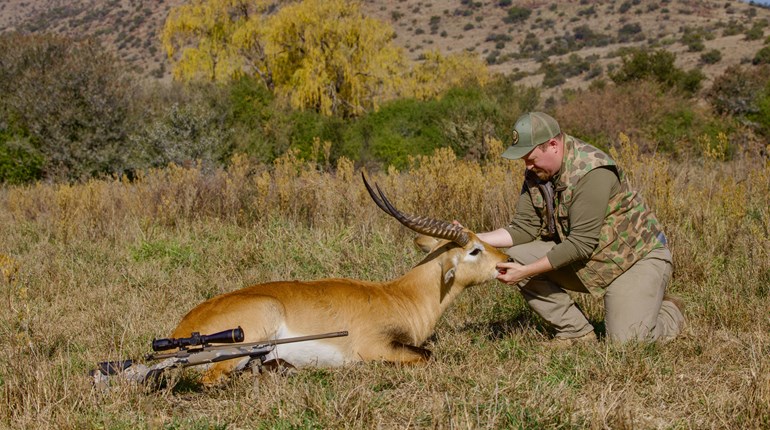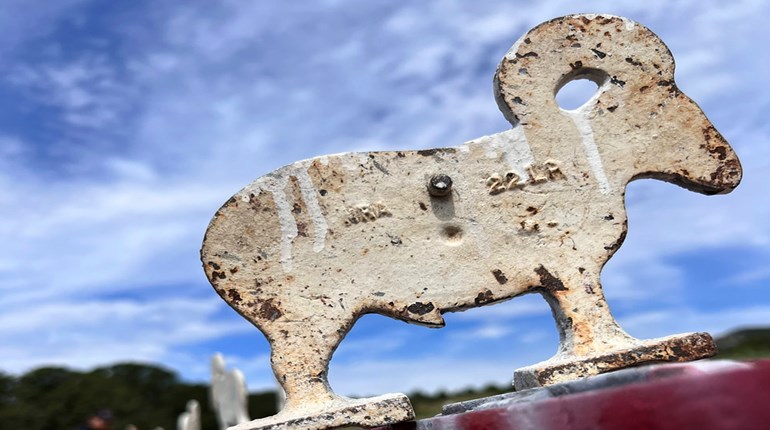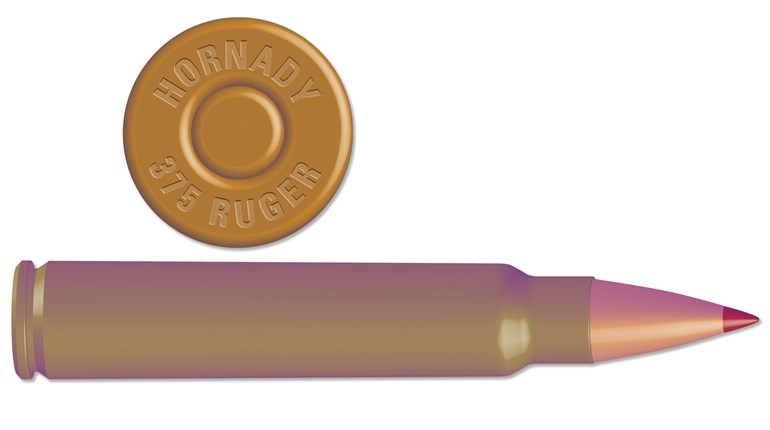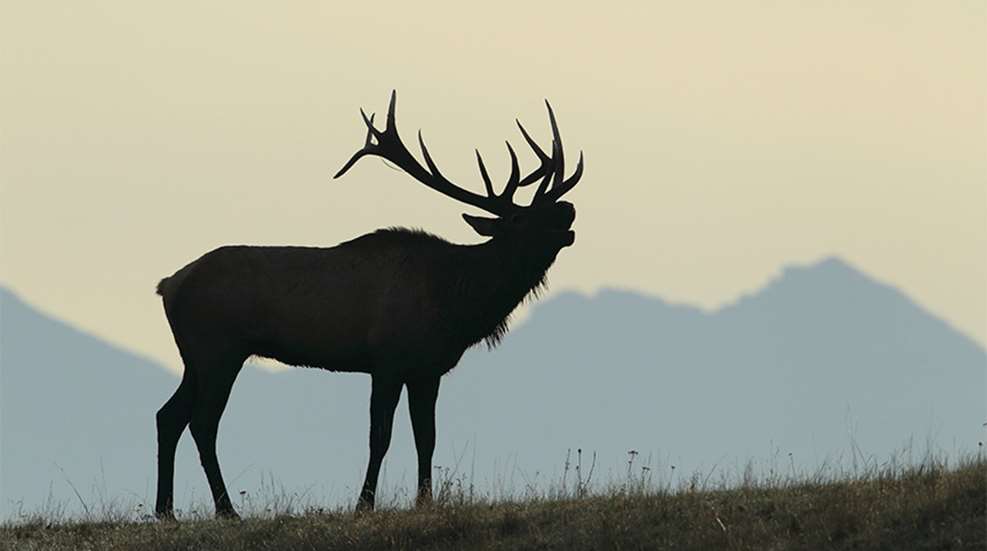
It was reminiscent of one of those scenes from the classic tales of knights and dragons—the climactic moment in which the heroic knight, hot on the heels of a town-tormenting beast, torchlight in one hand, steel in the other, realizes he has unwittingly stumbled into a previously unknown lair. As he slows to a crawl, the knight’s dimming light begins to reveal the true nature of the critical situation caused by his hasty pursuit. With each flicker, it becomes harder to breathe. The ground beneath him, covered with the bones and armor of the poor souls who dared tread here before, crunches with every step.
In other words, it was an “oh s&!t” moment, and Dakota Henson, my guide, said just that.
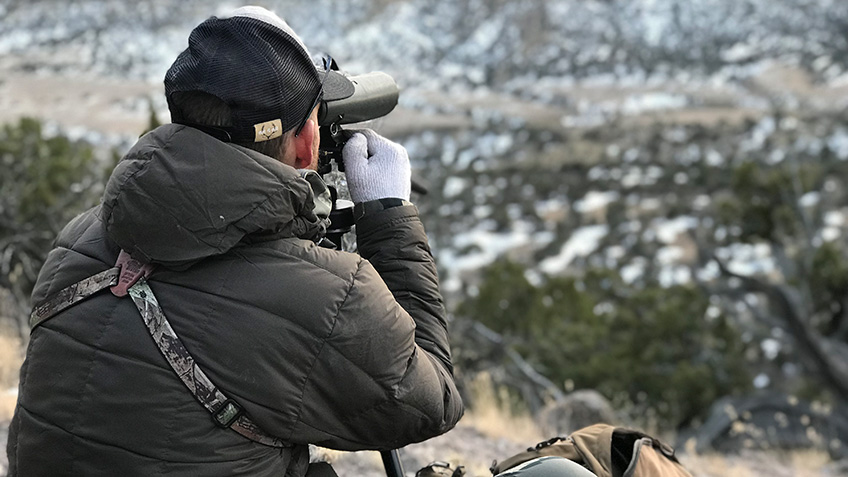
We’d been trekking these high New Mexico mountains and deep bowls for three days, and now, following fresh tracks in the snow, had stumbled into an elk lair. Prints covered the ground like hammer marks on a bronze chest plate, remnants of prior meals littered the earth and a dank forest-born musk hung heavy in the air. The sound of hooves crunching the frozen ground pulled my rifle from my shoulder. My eyes scanned intensely, keen to hone in on any sound or flicker of movement. My chest grew tight as I struggled to bring in a muted breath. Then we caught it, 30, no, 40 yards away through the thick pines: the tan of elk. Sticks down, sword drawn, we waited at the ready.
A trumpet, odd for this time of year, bellowed from a beast in slingshot range. Spinning, we caught antlers as they disappeared within the dense timber. To the left there was another flash of hide and horn. They were all around us. We stood our ground but a monster never showed. The noise faded, the smell lingered and we both stood dumbfounded as the herd moved off to faraway lands.
That’s how my week of elk hunting was shaping up—that is, until that very night when a friend noticed something I’m ashamed I hadn’t already.
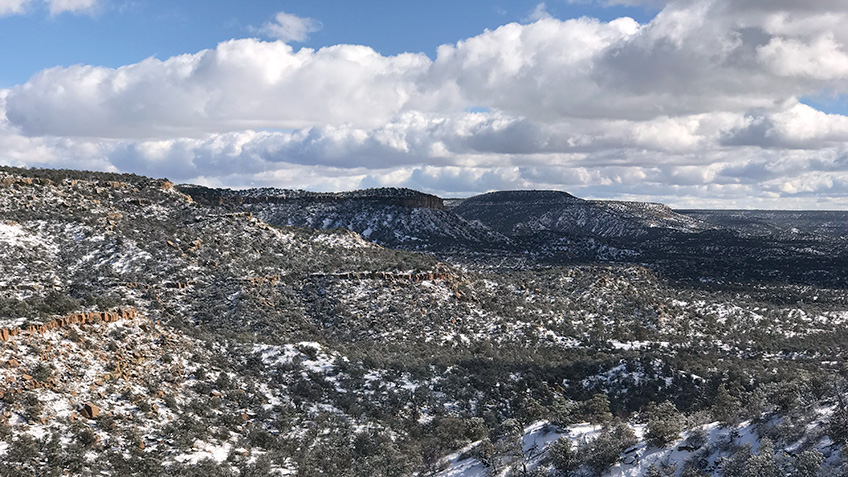
On any hunt, my battle attire usually provokes a question: “Where the hell did you get that vest?”
The question comes first from those who might have worn such a vest in its heyday, but equally, and with surprising enthusiasm from those closer to my age, who, like me, probably see a greater generation of men and hunters in its muted, faded earth-tone camo pattern, almost as if the dull greens and browns were seen in black and white.
I always respond, “It’s my lucky vest. It’s one of the items I got a hold of after my grandfather passed away years ago. I’ve worn it on every hunt I can remember.”
Designated as “old school” by much more than its camo pattern, the vest belonged to my grandfather, and I’ve worn it on nearly every hunt I can remember. It’s a simple and time-tested garment. No, it isn’t made with the latest waterproof membranes, and its down filling lost nearly all its loft years ago, but like an unexplained wonder, Grandpa’s vest always delivers the perfect warmth when the chill takes hold and somehow keeps me regulated in milder climes. Though it rides under an outer garment in the most heinous of weather, it fits better than my favorite pair of trousers, despite any addition or subtraction of pounds I may have seen over the years. Most importantly, while the smell of his Dutch Masters cigars has long since faded from its cotton fabric, the vest has allowed Grandpa to accompany me on every hunt I’ve taken from a young adult until now; from Alaska to Argentina, from large game to small, waterfowl and upland, I never go hunting without that vest. It may initiate a few odd looks at first, especially in camps clad with the latest digital and photo-realistic patterns that outdoor writers are often tasked with testing, but I wear it with pride, always, on every hunt … until this one.
For some reason, on this hunt, though it was within easy reach, I decided to forgo my usual custom and simply don the provided Browning coat I was asked to test. And why not? Temperatures were all over the place, snow and rain were both possible and I had before me a technologically advanced concealment system, a suit of armor built specifically for the task and climate. And for three days, through a snow squall and over miles of terrain, the Browning gear kept me comfortable, warm and dry, inside and out—but it wasn’t lucky. Having been dealt one bad hand after another over the last few days, I needed a bit of luck. With one simple observation from Shaundi Campbell, I had it.
“You haven’t been wearing your vest, have you?” she asked.
Tomorrow was going to be a new day, complete with a lucky vest and a new party member, the traveling minstrel Shawn Skipper, senior public relations specialist from Leupold. Shawn brought to our new trio a bit of comic relief, fresh tales of his own luck-changing bull vanquished the day before, a willingness to run the camera and a footfall that could be heard for miles. A new day indeed.
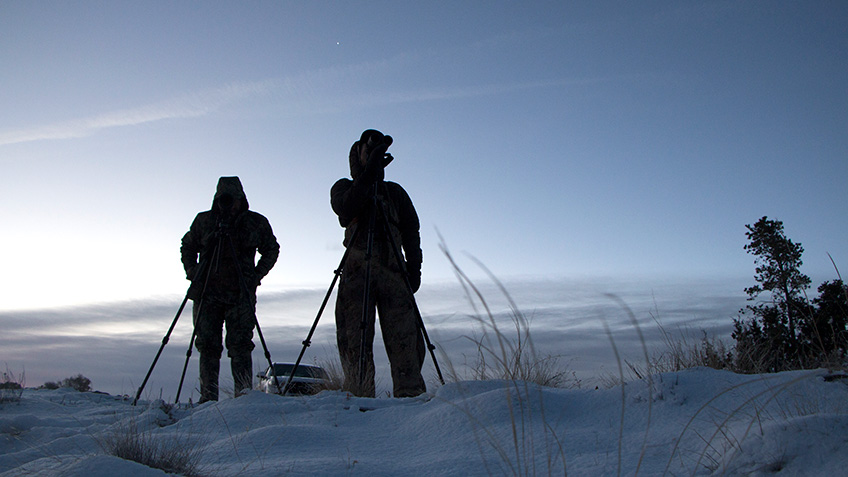
As the sun lifted over the horizon that morning, we found bulls. Of course, luck placed them more than 3 miles away, on the wrong side of the property line and on a steady course toward another hunter still searching for her own crown of antlers. Therefore, we relegated ourselves to the unchecked backside of the bowl we had been glassing for the past few days. Atop the once-distant peak by midday, despite the distractions offered up by our new minstrel, we were successful in spotting a few cows and smaller bulls. None of the bulls was worth chasing. Spotting the animals as they appeared and lingered in various shadows beneath cliffs from 1,000 yards and beyond was starting to seem like the closest I’d be able to get to success. As the sun dipped low toward the horizon, the reality of our now last-day-quest had me doubting the tenacity of our merry band of travelers, and even worse, doubting my lucky vest. Perhaps it was too little, too late.
My eyes opened the next morning with reignited vigor, but despite any positive aspirations I had upon its start, grabbing my boots from their warm home next to the fireplace revealed that if any luck was with me this day, it was surely bad. As if they’d danced with dragons, my synthetic boots had been set too close to the sun and melted overnight. Their soles were peeling, their seams splitting, any elemental protection they once provided now null and void. Whether it was the curse of bad luck or just a personal blunder mattered little. I donned my vest, pulled on the deteriorating boots and sluggishly hauled my heavy pack and rifle to the waiting chariot.
While my own attitude was marred by distress, any optimism I may have gained through the night now depleted, Dakota sported an aura of determination I hadn’t seen all week. He was like a man possessed. The plan was to glass the familiar bowl at break-neck speed, and if nothing showed, high-tail it to virgin ground. At the trailhead, the morning’s luck proved consistent. New tracks in fresh snow suggested the animals we’d hoped would be feeding below us had instead left the country overnight. Continuing down to the bowl’s vantage point, our fears were realized. As if they’d built a road to the neighboring kingdom, the elk left a visible story of their departure in the valley below.
Back in the 4x4, Sir Lead-Foot behind the wheel, we raced on, hoping to catch a sign. Around the next bend, Dakota slammed on the brakes and threw it into reverse.
“Tracks.” he said. “Three big bulls. Last night.”
As I reached to unlatch the door, assuming we’d bail out here and repeat our failing tactics, Dakota threw the vehicle back into drive, looked at me and smiled.
“And I know where they’re headed.”
“It ain’t over yet, brother,” added Shawn.
A quarter-mile later, we pulled off the road and put boots on the ground. Moving at a quick pace, we covered about 500 yards before the forest opened up. We’d reached our vantage point, a high mountaintop overlooking a steep canyon that formed the intersection for the various draws that spread out from its center. At less than 1,000 yards across, glassing from that one location would provide an up-close look at nearly every inch of rock and shadow that lay before us. It was a beautiful spot, truly: picturesque and quiet. But with glass to my eye, I couldn’t help but notice it was also completely empty.
And then Dakota spotted it. On the far side of the ravine, leading off the mountain down into the valley in front of us was a set of elk tracks in the snow.
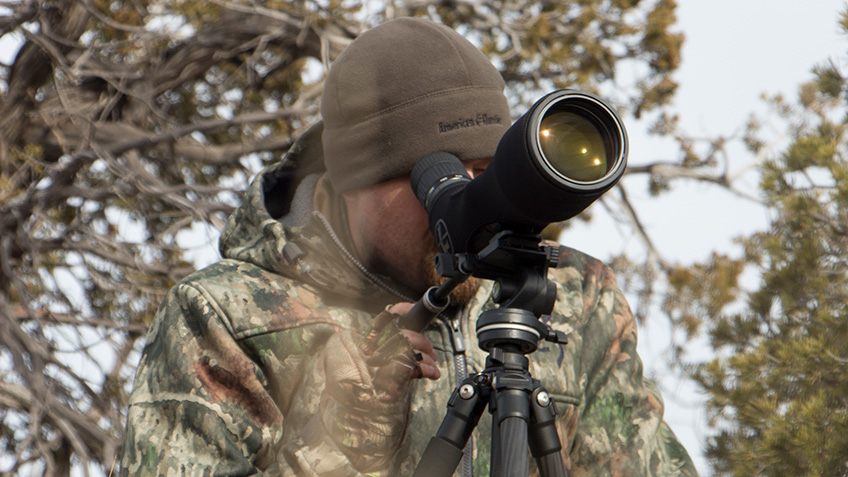
“That’s where they came in,” said Dakota, “and I don’t see any tracks leading out.”
Those tracks lit within me a tiny flame. Still, the evidence at hand wasn’t much more than we’d had all week—just another set of lifeless tracks in the wet snow.
An hour passed, and I was nearing acceptance. This simply wasn’t going to happen, it wasn’t meant to be. And with a defeated, yet calm demeanor, I stuck my hands deep into the warmth of my vest pockets and looked up toward the sky.
Grandpa, I thought, it’s been a heck of a trip and I’m glad that we at least got to experience this together.
With a sigh, I turned my attention back toward distant peaks. I couldn’t escape the annoyance of knowing that in this vast country, there were elk hiding somewhere just out of view. I turned toward Grandpa for one last quip.
But since I’m here and all, and I am wearing your vest, how about you get those old legs moving and find me an elk! Come on Grandpa, time is a wasting!
It was a fleeting thought. I was ready to catch a flight home. Ready to forget. Dropping some not-so-subtle hints, I grabbed my pack, capped my optics and began to gather the remainder of my gear.
Dakota was having none of it. He wasn’t into quitting, and though beat, neither was I. For his next calculated play, Dakota moved 50 yards to the left to view from a slightly different angle the ground we’d already covered with glass many times over. I reluctantly followed, with Shawn’s crunching footfalls close behind. Dakota sat down and began to do what persistent guides do. I stood behind him, twiddling my thumbs, waiting out the clock or cold, whichever enticed him to pack it up first.
For 10 long minutes all was quiet, until the familiar sound of large footsteps on frozen ground interrupted the silence.
This time, however, it sounded as though Shawn had absolutely no intention of even attempting to mute his footfalls.
Turning to follow the sound and scold its maker, I expected to see our minstrel skipping off to answer the call of nature in a distant bush—but I didn’t. As it happened, Shawn still stood directly behind me.
He shrugged his shoulders, and the loud crunch of feet through frozen snow echoed once again. With eyes wide, Shawn pointed to the timber. I spun back toward Dakota, looking for a reaction to validate what we were hearing, but he was motionless. His eyes were still glued to glass, fixed on a point somewhere in the distance.
Then we heard it again, louder and more distinct, definitely the sound of moving elk. Dakota’s head snapped to the left, and mine followed suit. Three bull elk burst onto the scene and were now charging down the valley in front of us. They came from no more than 75 yards away on the very same hill where we sat.
If Shawn hadn’t had the wherewithal to hit the record button on the camera, I wouldn’t be able to describe what happened next.
In an instant, Dakota stood and threw up his sticks, bino still attached on top, and I stepped forward—“Lead bull, 200 yards!”
I quickly twisted the CDS dial on the Leupold to 200 yards and somehow found a steady perch atop the curved bino housing—“250 yards,” said Dakota.
The elk were moving fast, a staggered yet single-file line of bulls running directly on a path that in a few seconds would lead them up and over the next hill to freedom. I cranked the turret to 300—“350,” called out Dakota.
I found the elk through my scope and pulled up to match pace with the lead bull—“400! Let it go, let it go!”
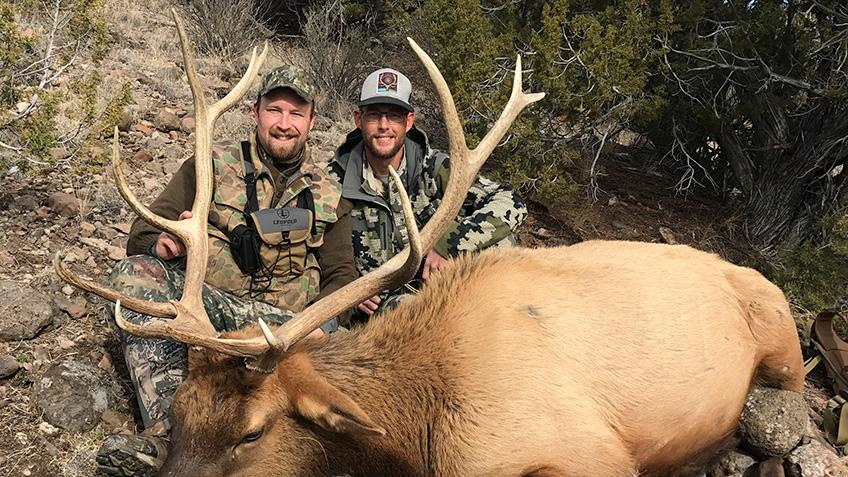
The lead bull neared the top but just before the crest, as a whistle rang across the canyon, he slowed and hesitated. I held high and squeezed.
Lucky vest, indeed.
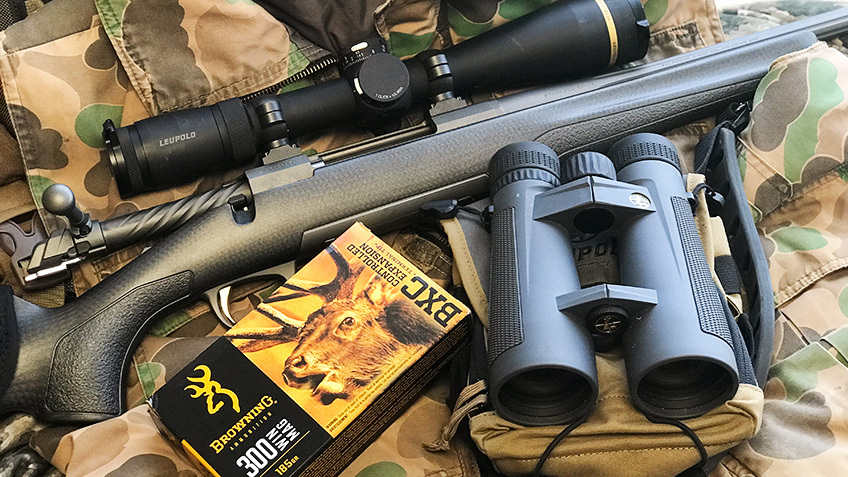
The Right Combination
Slaying dragons the size of elk, at distances that can vary from an in-your-face 50 yards to 500 yards and beyond, requires the right combination of bullet, rifle and optics.
The hard-hitting and flat-shooting .300 Win. Mag. will best nearly any beast in North America. Browning’s 185-grain BXC load delivers a bonded bullet that maintains nearly 1,900 ft.-lbs. of energy at 400 yards, penetrating deep through bone and hide. I actually took two shots on my elk; the first had him tumbling like a discarded coconut down the canyon, and the second shot simply ended it quicker once he stopped. I found the second bullet over 90 percent intact and mushroomed perfectly under the far-side skin.

The Browning X-Bolt Pro Tungsten rifle I used is one of the best for hunters making long tracks of their own in rough country. Not only is it insanely accurate, but its carbon-fiber stock, fluted bolt and fluted, sporter-contour barrel keep weight to a manageable 6 pounds, 9 ounces. A Cerakote finish protects metal parts from sticker bushes and careless operators. MSRP: $2,069.99-$2,129.99; browning.com.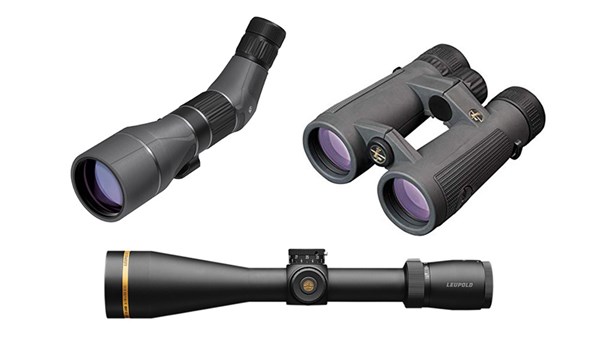
While they could always run right out in front of you, most Western hunts require quality glass to spot elk. Leupold’s VX-6HD riflescope, mine a 3X-18X-44mm, is as top-of-the-line as glass gets. Add Leupold’s Custom Dial System (CDS) turret matched to the load you’re shooting and a little knowledge of bullet drop at various distances, and “dialing” to your target can be extremely fast and effective. The BX-5 Santiam HD 12x50 binocular and SX-5 Santiam HD 27X-55X-80mm spotting scope both spent hours against my eyes and delivered crisp sight pictures during bright, midday glassing to well past sundown with no resulting eye strain. Even better, all of my optics were made in the USA. MSRP: VX-6HD, $2,079.99; BX-5 Santiam HD 12x50, $1,754.99; SX-5 Santiam HD, $2,339.99; leupold.com.












